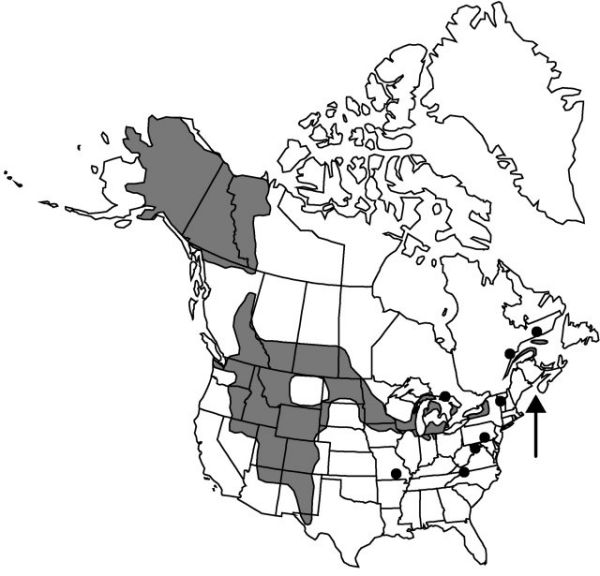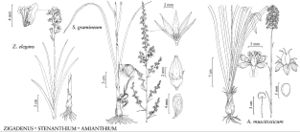Zigadenus elegans
Fl. Amer. Sept. 1: 241. 1814.
Plants 2–8 dm, from bulbs; bulbs not clumped, tunicate, narrowly ovoid, 1.5–3 × 1–2 cm. Stems without persistent leaf-bases. Leaves: proximal blades 10–30 cm × 3–15 mm. Inflorescences loosely racemose to paniculate, 10–50-flowered, with 1–4 branches, 0.9–2.5 dm × 3–6 cm. Flowers: perianth perigynous, rotate to rotate-campanulate, 15–20 mm diam.; tepals persistent in fruit, cream colored to greenish, ovate, 7–12 × 4–5 mm, somewhat narrowed at base; gland 1, obcordate; pedicel erect at anthesis, 1–2.3 cm, bracts often tinged with purple or pink, ovate, 5–20 mm. Capsules narrowly conic, 10–20 mm. 2n = 32.
Phenology: Flowering Jun–Aug.
Habitat: Moist grasslands, river and lake shores, bogs in coniferous forests
Elevation: 0–3600 m
Distribution

Alta., B.C., Man., N.W.T., Ont., Que., Sask., Yukon, Alaska, Ariz., Colo., Idaho, Ill., Ind., Iowa, Md., Mich., Minn., Mo., Mont., Nebr., Nev., N.Mex., N.Y., N.C., N.Dak., Ohio, Oreg., Pa., S.Dak., Tenn., Tex., Utah, Vt., Va., Wash., W.Va., Wis., Wyo., Mexico
Discussion
Zigadenus elegans has been treated previously as comprising two varieties, or two subspecies (W. B. Zomlefer 1997b). The western var. or subsp. elegans tends to be a smaller plant with a raceme or a 1–2-branched panicle and glabrous, sometimes glaucous leaves and stems; while the eastern var. or subsp. glaucus tends to be a larger plant with a paniculate inflorescence and glaucous leaves and stems. Because there is considerable evidence of intergradation between the two entities toward the middle of the range, including overlapping flowering times, they have not been formally distinguished here.
Selected References
None.
Lower Taxa
"broad" is not a number."dm" is not declared as a valid unit of measurement for this property. "dm" is not declared as a valid unit of measurement for this property."thicker" is not a number.
